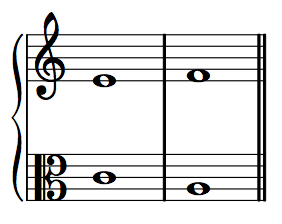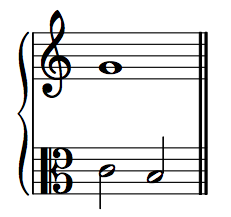Integrated Music Theory 2019-20
Discussion 5a - Introduction to Counterpoint
Class discussion
Define counterpoint:
- Strict voice leading; lots of rules to follow? (On the right track: it’s definitely a very strict system)
- Studying melody, specifically studying melody that is two melodies happening at the same time
Consonant and dissonant intervals
- Perfect consonances: P1, P5, P8
- Imperfect consonances: M3, m3, M6, m6
- A note: “consonant” and “dissonant” in this style = “allowed” and “not allowed.” P5s, P8s, M3s, etc. are allowed, whereas P4s are not.
Types of contrapuntal motion
- Parallel: same direction of melodic interval, same size harmonic interval (not necessarily the same quality)
- Contrary: opposite direction of motion, intervals don’t matter
- Oblique: one voice is stationary, the other moves
- Static: no movement in either voice
- Similar: same direction, different harmonic interval sizes
Further reading
From Open Music Theory
Types of contrapuntal motion
There are four types of contrapuntal motion between two musical lines. Differentiating these four types of motion is essential to generating good voice-leading, both strict and free.
In parallel motion, two voices move in the same direction by the same generic interval. For example, the following two voices both move up by a step. Note also that both dyads form the same generic interval (sixth). This will always be true when two voices move in parallel motion.

In similar motion, also called direct motion, two voices move in the same direction, but by different intervals. For example, the following two voices both move down, but the upper voice moves by step while the lower voice moves by leap. Note also that the two dyads are different generic intervals. This will always be the case with similar or direct motion.

In contrary motion, two voices move in opposite directions—one up, the other down.

In oblique motion, one voice is stationary, while the other voice moves (in either direction). The stationary tone may or may not be rearticulated.

or
